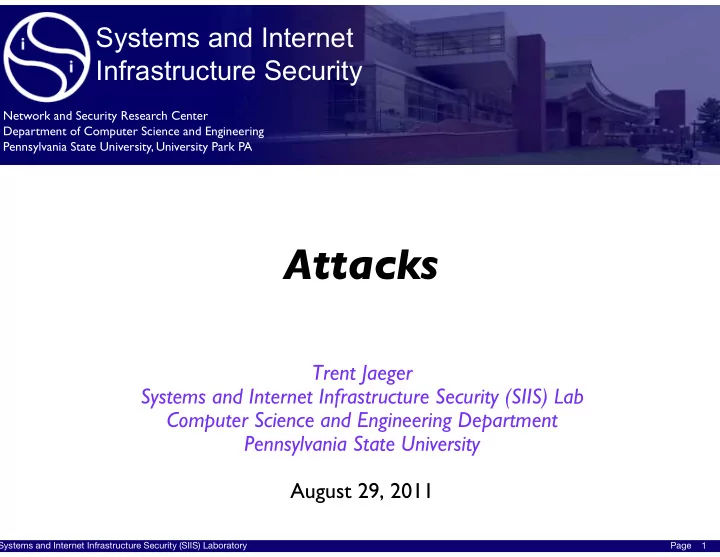

Systems and Internet Infrastructure Security Network and Security Research Center Department of Computer Science and Engineering Pennsylvania State University, University Park PA Attacks Trent Jaeger Systems and Internet Infrastructure Security (SIIS) Lab Computer Science and Engineering Department Pennsylvania State University August 29, 2011 Systems and Internet Infrastructure Security (SIIS) Laboratory Page 1
Introduction • Problem – Attacks on software and systems • Classical attack – Buffer overflow • Attack: (1) Change control and (2) Run code • Other forms of attack • Return-oriented attacks • Stuxnet Systems and Internet Infrastructure Security (SIIS) Laboratory Page 2
Our Goal • In this course, we want to develop techniques to detect vulnerabilities and fix them automatically • What’s a vulnerability? • How to fix them? • We will examine the first question today Systems and Internet Infrastructure Security (SIIS) Laboratory Page 3
Vulnerability • How do you define computer ‘vulnerability’? Systems and Internet Infrastructure Security (SIIS) Laboratory Page 4
Buffer Overflow • First and most common way to take control of a process • Attack code Call the victim with inputs necessary to overflow ‣ buffer Overwrites the return address on the stack ‣ • Exploit Jump to attacker chosen code ‣ Run that code ‣ Systems and Internet Infrastructure Security (SIIS) Laboratory Page 5
Determine what to attack • Local variable that is a char buffer Called buf ‣ Systems and Internet Infrastructure Security (SIIS) Laboratory Page 6
Configure Attack • Configure following Distance to return address from buffer ‣ Where to write? • Location of start of attacker’s code ‣ Where to take control? • What to write on stack ‣ How to invoke code (jump-to existing function)? • How to launch the attack ‣ How to send the malicious buffer to the victim? • Systems and Internet Infrastructure Security (SIIS) Laboratory Page 7
Return Address • x86 Architecture Build 32-bit code for Linux environment ‣ • Remember integers are represented in “little endian” format • Take address 0x8048471 See trace at right ‣ Systems and Internet Infrastructure Security (SIIS) Laboratory Page 8
Find Return Address Offset Systems and Internet Infrastructure Security (SIIS) Laboratory Page 9
Exploits • Run code determined by attacker • Old way Include attack code in buffer value ‣ Prevented by modern defenses: NX and ‣ randomized stack base • Modern way Return-to-libc attack ‣ Configure the stack to run code in the ‣ victim’s address space Systems and Internet Infrastructure Security (SIIS) Laboratory Page 10
Find Addr to Call Shell Fn • Jump to location where call to shell function occurs (In main function) • What address is this at? Need to look at assembly code ‣ • Step 1: Build victim in assembly ‣ ‘make victim.s ‣ • Step 2: Insert label before call to shell and rerun ‣ ‘make victim-label’ ‣ Systems and Internet Infrastructure Security (SIIS) Laboratory Page 11
Add Label before Call • In cse544-victim.s Systems and Internet Infrastructure Security (SIIS) Laboratory Page 12
Launch Attack • Execute the victim program with the malicious buffer From the attack program ‣ Use the system system call to involve the exec ‣ system call on victim Systems and Internet Infrastructure Security (SIIS) Laboratory Page 13
Anatomy of Control Flow Attacks • Two steps • First, the attacker changes the control flow of the program In buffer overflow, overwrite the return ‣ address on the stack What are the ways that this can be done? ‣ • Second, the attacker uses this change to run code of their choice In buffer overflow, inject code on stack ‣ What are the ways that this can be done? ‣ Systems and Internet Infrastructure Security (SIIS) Laboratory Page 14
Return-oriented Programming • General approach to control flow attacks • Demonstrates how general the two steps of a control flow attack can be • First, change program control flow In any way ‣ • Then, run any code of attackers’ choosing, including the code in the existing program Systems and Internet Infrastructure Security (SIIS) Laboratory Page 15
Return-oriented Programming • ROP slides Systems and Internet Infrastructure Security (SIIS) Laboratory Page 16
Stuxnet • Stuxnet slides Systems and Internet Infrastructure Security (SIIS) Laboratory Page 17
Summary • The types of attacks that we must defend against are becoming more complex • Return-oriented programming shows us that any attacker-dictated change in program control flow can lead to arbitrary malice • Stuxnet shows that ad hoc system defenses can be evaded by an adversary • We must apply principled approaches to defense to make significant strides in defense Systems and Internet Infrastructure Security (SIIS) Laboratory Page 18
Recommend
More recommend